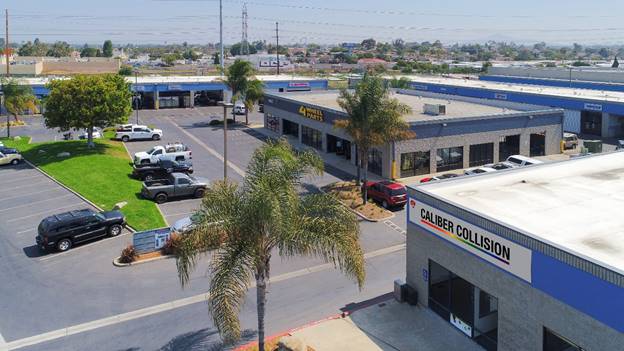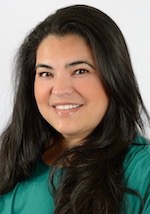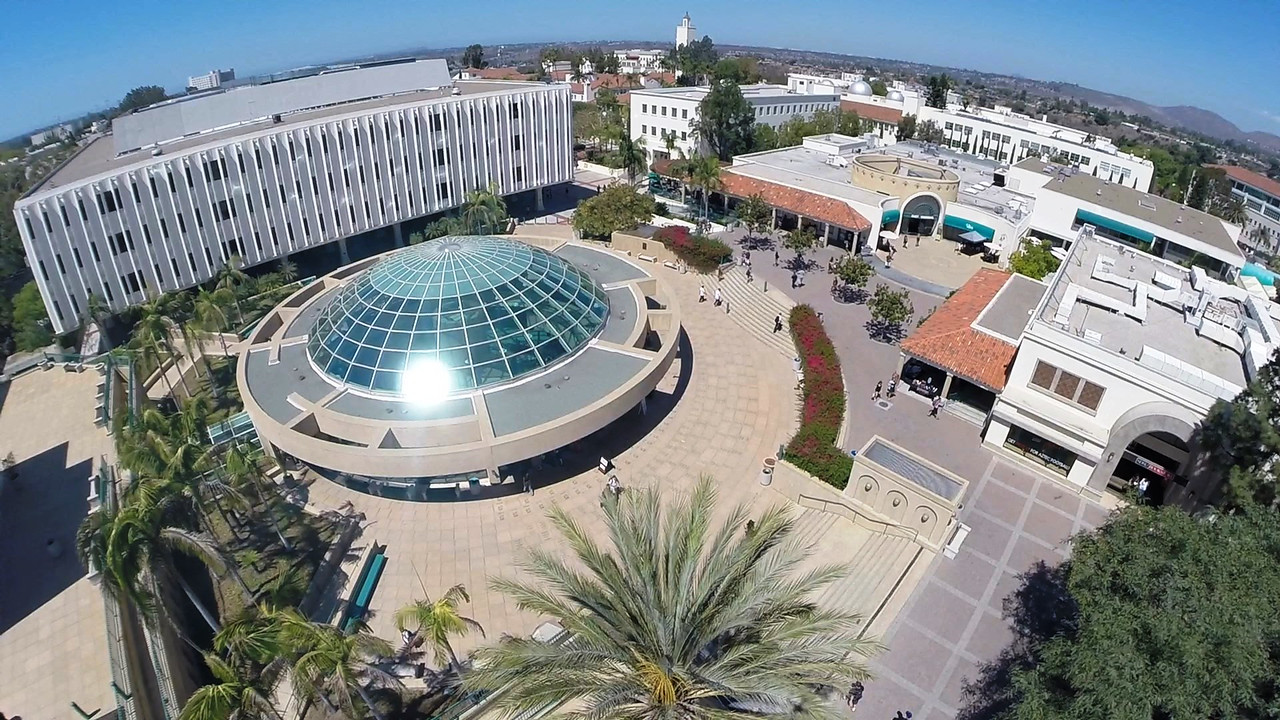Daily Business Report-March 26, 2018
Aerial photo of the San Diego State University campus. (Photo courtesy of SDSU)
Thousands of College Hopefuls Could
Leave California, and Never Come Back
By Vanessa Rancano, KQED
This month, to mark the 150th anniversary of the University of California, President Janet Napolitano laid out steps to meet growing demand. She called on chancellors to graduate more students in four years, clearing the way for new students, and advocated for a policy that would guarantee admission to qualified community college transfer students.
Meanwhile, CSU trustees approved policy changes to redirect eligible applicants to campuses with space, instead of rejecting them outright. The changes go into effect for fall 2019 applicants.
But as California’s public universities scramble to accommodate more students, nearby out-of-state schools are welcoming them with open arms.
Two years ago, Danny Holton was the one waiting. He was a senior at Mountain View High School, in the heart of California’s tech mecca.
He had a 3.85 GPA. It wasn’t the 4.6 some of his classmates had, but still, he felt good about his prospects, and lucky to be in California. “I grew up in a place where there are all these great schools just hours away,” he says. “Other states don’t have this opportunity just laid out.”
Holton loved how friendly people were at his top pick, CalPoly San Luis Obispo. He also liked the UC campuses in Davis, San Diego and Irvine with their big green spaces where students studied in the sunshine. He was excited to turn in his applications. “You know, my whole high school career kind of led up to this point, you know, getting the acceptance letters from CalPoly, the UCs.”
When the letters started coming in it was bad news. “They just kept coming. It was like the same letter, San Diego Davis, Irvine: We regret to inform you that we won’t let you in.” CalPoly didn’t let him in either. “No wait list,” Holton says, “It felt like I wasn’t even close.”
It’s become a common story. Last year, the CSU system turned away more than 30,000 eligible students. In 2017, UC turned more than 10,000 eligible applicants away from their schools of choice, instead referring them to the only campus that has room to grow: UC Merced. 124 of those students say they plan to enroll there.
As California’s population grows, and increasing numbers of high school grads meet college eligibility requirements, ever more qualified CSU and UC applicants have to compete for limited space, according to experts at the Public Policy Institute of California, who say the problem is compounded by a long-term trend toward declining state investment. PPIC data shows in 1976–77, higher ed spending made up 18 percent of the state budget, but by 2016–17 it had fallen to 12 percent of the budget.
While California’s demographics have changed, its propensity for growth hasn’t.“One of the main themes in California history is constant population growth,” says John Douglass, a research fellow at UC Berkeley’s Center for Studies in Higher Education and author of “The California Idea and American Higher Education.”
The difference now, he argues, is a lack of vision. The feat of California’s famed 1960 Master Plan for Higher Education was not that it established an accessible high-quality college system — that already existed — but that it secured that promise for the future. “The great legacy of the Master Plan was an agreement about how the system should grow, what campuses should be developed, and what kind of money would be involved,” Douglass says.
It was supposed to be a plan through 1975, but the state hasn’t come up with an alternative. “We’re living off of infrastructure and an investment by the state that’s 50 years old,” he says.
So what students like Holton are experiencing is in part the result of a failure to adequately plan for the boom in college-eligible high school grads, Douglass says.“We don’t have anybody doing any long term enrollment studies as of now, so we need a lot of homework to be done.”
As Holton’s rejection letters piled up, he was grateful he had a backup plan. His college counselor had urged him to apply to a few out-of-state schools, and the news from outside California was better.
“When I got my acceptance from ASU (Arizona State University), that was awesome,” Holton says. He even got a certificate with his name on it, signed by the dean welcoming him to the undergraduate business school.
Not only did Arizona State University welcome Holton, they offered him $54,000, or about half his tuition for four years.
Holton was placed on the waitlist at UC Santa Cruz and eventually admitted. But that was not until the summer, long after he had accepted admission to ASU.
The decision to leave the state for college is one a growing number of California families are making. Since 2002, Arizona State University has seen an increase of more than 200 percent in California student enrollment. At Oregon State University, California freshmen made up 3 percent of the incoming class in 2002. By 2017, California freshmen made up nearly 14 percent of Oregon State’s new students.
The last available U.S. Department of Education data, from 2014, shows more than 36,000 California freshman enrolled at out-of-state schools.
Those statistics trouble Lande Ajose, executive director of California Competes, an organization that advocates for higher education policies that increase access. “Those are bright and talented students,” she says. “Those are students whose families are here in the state. Those are students who then may or may not return home.”
Holton is glad he went to ASU. He likes his classes, he got a good internship. He has another two years of college to decide what he’ll do next, but the longer he stays in Arizona, the harder it gets to leave. “I just have the connections here,” he says. “This is where I am now. I’d call it my home.”
If Californians like Holton don’t come back, analysts warn the state is headed for trouble. The PPIC estimates by2030 nearly 40 percent of the jobs here will require at least a bachelor’s degree, and state universities just aren’t turning out nearly enough of them. The institute projects the state will be over a million workers with bachelor’s degrees short of economic demand by then.
“Without a focus on how we’re going to move kids through,” Ajose says, “we’re leaving industries at risk of not being able to find the talent that they need to have.”
And she points out it’s not just about the economy. Studies have shown college graduates are more likely to be engaged in civic activities like voting and volunteering. “It also matters for the kinds of communities we want to live in,” Ajose says.
There is work being done on campuses and at the State Legislature to address the bleak forecast. Lawmakers mandated UC increase enrollment by 10,000 in-state students over three years, a target the system has already surpassed. CSU’s Graduation Initiative 2025 aims to help students graduate on time, freeing up more space for new students, and there are signs it’s working: for 2016-17, 99,000 CSU undergrads earned degrees — almost 7,000 more than the year before, and a record high.
But experts warn more will need to be done if California is going to live up to the promise of access that created one of the greatest higher education systems in the world. “Without a significant increase in the enrollment and academic program capacity,” Douglass says, “Californians can’t expect to continue to have the access rates they have today, let alone yesterday.”
The California Dream series is a statewide media collaboration of CALmatters, KPBS, KPCC, KQED and Capital Public Radio with support from the Corporation for Public Broadcasting and the James Irvine Foundation.
___________________

Navy Completes Test for New
Mine Detection Drone System
The U.S. Navy has completed tests for a drone-based mine detection system made to deploy from littoral combat ships, Military.com reported.
The Coastal Mine Reconnaissance system makes use of an MQ-8B Fire Scout drone and an AN/DVS-1 Coastal Battlespace Reconnaissance and Analysis or COBRA sensor to detect mines and obstacles on surfaces and coastal areas.
The MINEnet Tactical web system is also employed to facilitate the CMR’s command and control functions for mine warfare.
The Navy commenced the tests from the USS Coronado, having conducted nine exercises that were evaluated based on shore-based mission-tasking, planned mission flying and data analysis performance.
The service branch also seeks to employ drones built to identify and destroy enemy mines after detection, the report noted.
___________________
Employment Trends:
Report from San Diego’s Economic Pulse
San Diego Regional EDC
February data show a stable San Diego labor market. The unemployment rate (3.5 percent) decreased slightly from January and still remains near record lows.
- Total nonfarm employment increased by 11,500, or 0.8 percent, in February — a healthy increase following the decline experienced in January post-holiday season.
- The largest job increases in February came from professional, scienti c, and technical (PST) services, up 3,700 jobs. Retail saw the largest decline during the month, losing 3,800 jobs.
Click here for the full Economic Pulse report from the San Diego Regional EDC.
___________________

South Bay Autoplex LLC Acquires
South County Autoplex for $10.2 Million
South Bay Autoplex LLC has purchased a 62,855-square-foot automotive retail center — South County Autoplex — located at 1403-1427 Broadway in Chula Vista,, for $10.2 million. The seller was Autoplex Broadway LLC, an LLC created by The Heritage Group for a group of its private investors.
Senior directors of The Heritage Group, Dan McCarthy and Kyle Clark, represented the seller in the transaction, while broker Tom Holland and James Duncan of Kidder Matthews represented the buyer.
“When this property was acquired, there had been a significant level of deferred maintenance and lack of active management,” said Clark. “Through Heritage’s efforts, the physical plant was refined, enabling the leasing team to enhance the tenant mix with stronger local and national tenants at significantly higher rents.”
Heritage converted South County Autoplex from an industrial auto repair facility to a high-quality retail auto service facility in just over two years. The Heritage Group acquired the asset in 2015 for $5.95 million at 83 percent occupancy. The five-building automotive retail center is currently 100 percent leased with 49 percent of the occupancy attributed to national tenants. The Heritage Group most recently signed Caliber Collision and AAMCO as new tenants.
The Heritage Group will retain management of South County Autoplex. “This project required us to roll up our sleeves and focus on building strong
___________________
BASIC moves to Makers Quarter
Creative design firm BASIC Agency is moving its headquarters to Block D of Makers Quarter, Downtown San Diego’s design and innovation district.
“Block D” is the first office building within the new Makers Quarter development, which focuses on bringing a creative workplace to the city’s urban core. This new environmentally conscious infrastructure has the capability to become Downtown’s first net-zero building.
___________________
Crinetics Pharmaceuticals Raises $63.5M
San Diego biotech Crinetics Pharmaceuticals, taking aim at endocrine-related cancers and endocrine disorders, raised $63.5 million through a Series B financing round. The proceeds will go toward the development of a treatment for the hormonal disorder Acromegaly, additional therapeutics for endocrine conditions, and general corporate functions.
___________________
Personnel Announcements
Joanna Robinson Promoted at Burwood Group

Joanna Robinson, former regional vice president of West Coast operations at Burwood Group, based in San Diego, has been appointed to a national role as senior vice president of technology. Also promoted were Phillip Hodge, vice president of sales; Jennifer Courtney, vice president of professional services; and Colleen Barry, director of marketing communications.
“We are excited about the impact expected from these changes and are confident these leaders will drive our future direction and success,” said Jim Hart, president at Burwood Group. “Joanna has been a transformational leader in Burwood’s California market, quickly establishing herself by doubling revenues in just twelve months while building a strong team and culture. Elevating her to a national role enables us to execute on critical sales and delivery goals in existing and new markets.”
___________________
Vanessa Davis Named General Manager of Broadway/San Diego

Vanessa Y. Davis has been named general manager of Broadway/San Diego, A Nederlander Presentation.
Davis takes over many of the duties of Vice President Joe Kobryner, who announced his retirement in January. Kobryner will remain with Nederlander through July 13, 2018.
Davis currently oversees Broadway/San Diego’s President’s Club, Group Sales and Patron Services.
She’s also served on the board of Executive Women International, recently as president of the San Diego chapter, and for the last six years has been a member of the National Broadway Leagues’ Group Sales Committee.




